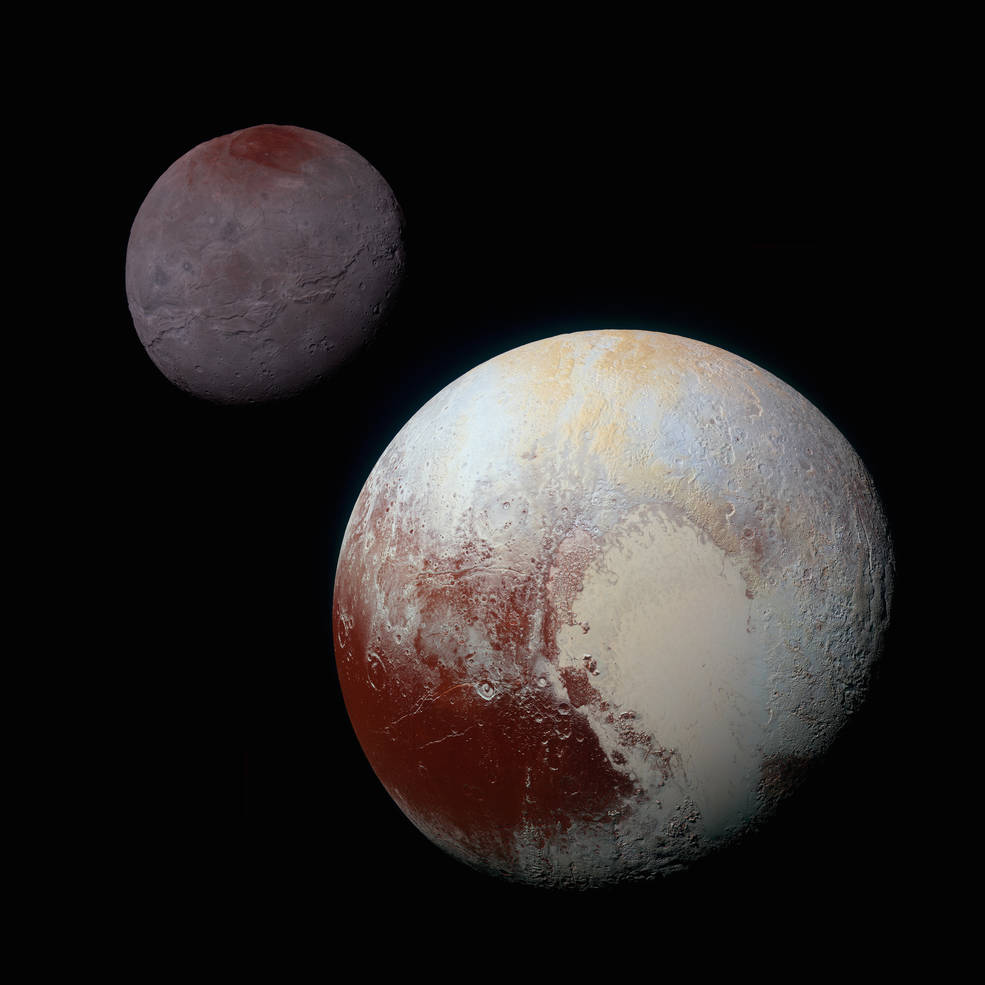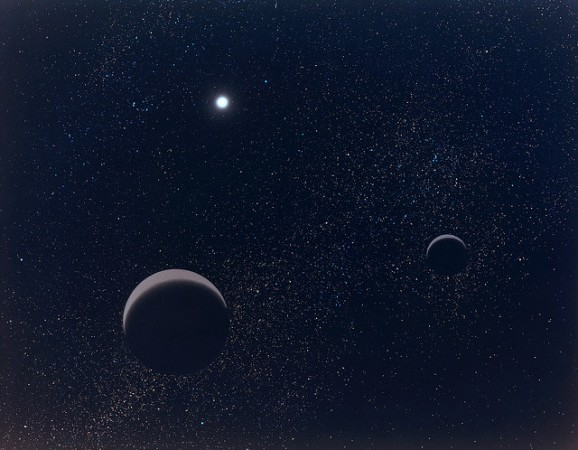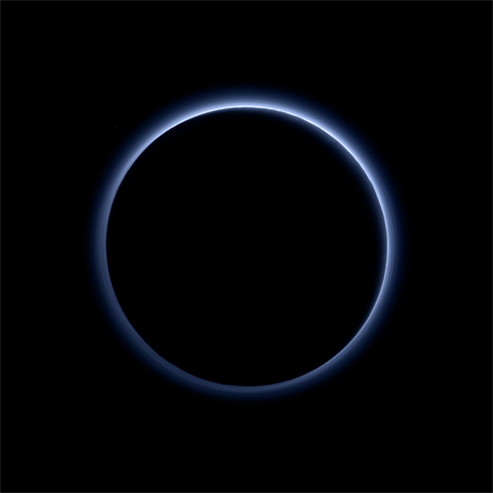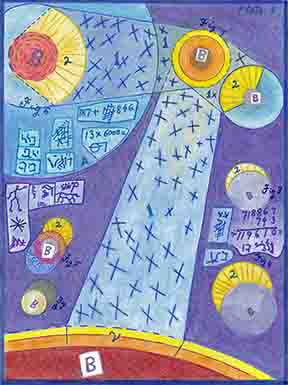Oahspe Study and Faithism
What about Pluto
Is it or Is it Not a Planet?
|
|
|
|
Pluto is one of thousands of external nebulae which Oahspe has stated exist outside the sun's vortex. |
Who among us grew up with Pluto as the 9th Planet --- the most distant and smallest in the Solar System? How many were shocked or even grieved when it got demoted to Dwarf Planet in 2006?
Pluto was downgraded from a full blown planet because it did not satisfy certain criteria that a convention of scientists (the International Astronomical Union (IAU) agreed defines a planet. Was the decision a wise move? The reclassified Pluto joined the growing crowd of dwarf planets such as Ceres in the Asteroid Belt, and some of the more significant objects in the Kuiper Belt, such as Eris, Haumea and Makemake.
Pluto, a planet since 1930, got the boot
because it didn't meet the new rules, which say a planet not only must
orbit the sun and be large enough to assume a nearly round shape, but must
"clear the neighborhood around its orbit." That disqualifies
Pluto, whose oblong orbit overlaps Neptune's, downsizing the solar system
to eight planets from the traditional nine.
In defiance of Pluto's "downgrade", in 2017 and 2018 some scientists gathered in Houston and declared only one criteria for a planet: "round objects in space that are smaller than stars". In which case not only would Pluto be reinstated as a planet, but many moons would also be planets as well as some asteroids and many more Kuiper Belt Objects.
Back in the days before Pluto's "humbling" reassignment, many Oahspe readers wondered why Oahspe, first published in 1882, showed Neptune and Uranus as the last planets within the Sun's vortex. Some thought it was an error, others thought it was because Pluto had not yet been discovered by modern telescopy. (Pluto was discovered in the first months of 1930 By Clyde Tombaugh).
Unlike the discovery of Neptune, found through mathematical calculations because it caused specific and sufficient perturbations to Uranus' orbit, by contrast, the strange perturbations (caused by yet-to-be-discovered Pluto) in Neptune's orbit caused by an unknown object or objects made the cause difficult to pinpoint. There was no agreement as to cause, but some astronomers supposed the perturbations to come from a ninth planet, farther out than Neptune. But where to look? Which haystack would have the needle that looks exactly like another piece of hay? So, even if you knew what part of the sky region to look in, the particular star / planet / celestial object causing at least some of the perturbations could only be discovered by its tiny, barely discernible movement, a search that had been going on decades before Pluto's discovery. This resulted in Pluto being discovered through a blink comparator --- using the same principle as motion pictures, a flickering back and forth between two images (shot at two different times) makes any difference in star / planet position show up as a movement.
The fact that there was no obvious sign that there might be a ninth planet, in itself indicates that Pluto was not in the same league as the other outer planets. Furthermore, just as there is a progression from very solid inner planets to larger gaseous bodies in the outer arena, so Pluto's solid body, insignificant size, and comet-like orbit also signals a change in the structure of the solar system in those outer reaches. In fact the downsizing of Pluto was more a public acknowledgement of what astronomers already knew since 1992. Let us see how this is so.
The Kuiper Belt was named after Dutch-American astronomer Gerard Kuiper, though he did not predict its existence. In 1992, Albion was discovered, the first Kuiper belt object (KBO) since Pluto and Charon. Since its discovery, the number of known KBOs has increased to over a thousand, and more than 100,000 KBOs over 100 km (62 mi) in diameter are thought to exist. The Kuiper belt was initially thought to be the main repository for periodic comets, those with orbits lasting less than 200 years. Studies since the mid-1990s have shown that the belt is dynamically stable and that comets' true place of origin is the scattered disc, a dynamically active zone created by the outward motion of Neptune *4.5 billion years ago [sic]; scattered disc objects such as Eris have extremely eccentric orbits that take them as far as 100 AU from the Sun. || Wikipedia (July 2018)
*4.5 billion years is an arbitrary, fictitious length of time - see example below re condensation processes in Pluto's atmosphere, also see Planetary Formation and the Rings of the Gas Planets.
A detailed account of the Kuiper Belt as understood by astronomers.
But did Oahspe overlook Pluto --- after all, Oahspe's images of the solar vortex and the Great Serpent (the Sun and its planets) occasionally included some of the larger asteroids which in the 1800's were considered small planets?
No Oahspe did not overlook Pluto, rather, it matter-of-factly prophesied that man could see the "Kuiper Belt Objects" (nebula) beyond the last planet within the sun's vortex.
Oahspe, Book of Cosmogony and Prophecy; 38/2.18.
There are at present, visible from the earth, more than eight thousand external nebulas, of sufficient size to be self sustaining, and to ultimately become planets. These are in the process of globe‑making, just as the earth was made. Of nebulas within the sun's vortex, where they are usually called comets, there are more than eight or ten new ones every year. Some of them survive only a few months, some a few years; some a hundred years; and some even a thousand or more years. But in all cases when the vortex of one of them bursts, the corpor of the comet flies instantly into dissolution, and being more sublimated, is lost to mortal sight.
With modern telescopes about 1000 objects in the Kuiper Belt have been identified, however since according to Oahspe, there are some 8,000 nebula visible from earth, man has yet to see many, many more.
Yet Oahspe has more to say on what constitutes a planetary vortex or a cometary vortex. And upon viewing the New Horizons' photos of Pluto's thin blue atmosphere (image below) --- and Pluto, small as it is, comes out on the Planet side!
Oahspe, Book of Cosmogony and Prophecy; 38/2.25.
A complete planetary vortex is a globe, or nearly so, and its manifested light is like that of a complete magnet. But for an immature vortex, as in the case of a comet or other small vortex, light will manifest at both poles, and sometimes in the middle---if it has attained to power to manufacture light of its own. In some cases the comet or the nebula is not sufficiently condensed to produce light of its own, but contains corpor in a gaseous state, which, itself, may have infinitesimal polarities refracting the normal light of the master vortex.
<
So it seems that Dwarf Planet is not such a shameful description, since Pluto IS a planet, albeit a very small one. Whether or not Pluto will grow any larger or if it wanders close enough to join the orbits of any of the gas planet moons is an interesting question to ponder as we observe the little traveller wending her way along a lopsided elliptical orbit around the outer edge of the solar system.
Where Does the Light Come From?
|
|
Pluto's Blue Sky: Pluto's haze layer shows its blue color in this picture taken by the New Horizons Ralph/Multispectral Visible Imaging Camera (MVIC). The high-altitude haze is thought to be similar in nature to that seen at Saturn's moon Titan. The source of both hazes likely involves sunlight-initiated chemical reactions of nitrogen and methane, leading to relatively small, soot-like particles (called tholins) that grow as they settle toward the surface. This image was generated by software that combines information from blue, red and near-infrared images to replicate the color a human eye would perceive as closely as possible. Credits: NASA/JHUAPL/SwRI Oct. 8, 2015 NASA:https://www.nasa.gov/nh/nh-finds-blue-skies-and-water-ice-on-pluto
|
A bluish atmosphere around Pluto! Scientists marvel wondering where the light is reflected from since the sun from that distance looks more like a bright star than a sun. But Oahspe explains --- same reason there is light on earth, the moon and mars --- because the Pluto has a vortex whose sun-facing-side is a condensing lens. There is sufficient vortexyan current even at the outer edge of the solar vortex to generate a vortexyan lens on Pluto!
So how do scientists reconcile the old belief that light from the moon (similar in size to Pluto), is reflected light, when there would not be enough light from the sun where Pluto is to even provide a ghost of a glimmer in its thin atmosphere?
The haze particles themselves are likely gray or red, but the way they scatter blue light has gotten the attention of the New Horizons science team. "That striking blue tint tells us about the size and composition of the haze particles," said science team researcher Carly Howett, also of SwRI. "A blue sky often results from scattering of sunlight by very small particles. On Earth, those particles are very tiny nitrogen molecules. On Pluto they appear to be larger --- but still relatively small --- soot-like particles we call tholins."
Scientists believe the tholin particles form high in the atmosphere, where ultraviolet sunlight breaks apart and ionizes nitrogen and methane molecules and allows them to react with one another to form more and more complex negatively and positively charged ions. When they recombine, they form very complex macromolecules, a process first found to occur in the upper atmosphere of Saturn's moon Titan. The more complex molecules continue to combine and grow until they become small particles; volatile gases condense and coat their surfaces with ice frost before they have time to fall through the atmosphere to the surface, where they add to Pluto's red coloring.
|
|
Reading the above explanation of what is causing the blue light on Pluto, one can appreciate scientists applying what they know from near-at-hand to that which is afar. Yet it is wise to remember that at best it is a subjective analysis colored by lack of understanding about the structure of the solar system including planetary formation and the nature of the vortices. While they comprehend the connection between the sun and the atmosphere, yet they do not understand that it is the power of the vortex and the lenses that form on the facing sides of each vortex that power the ionization and recombination of ions, and the generation of light within the vortexyan lens.
left: Oahspe Image of Vortexyan Lenses |
The paradigm of a static solar system some 4 or 6 billion years old (See Planetary Formation.) is a severe blind-spot for those who embrace this paradigm. Common sense informs that if, as the above quoted explanation states, nitrogen and methane are split and ionized to recombine into more complex molecules and continue to grow into particles, migrating down to the surface of the planet, causing a red tone on its surface, then there must be a source for the nitrogen and methane, since those elements are constantly being transformed into "tholins" and precipitating onto the planet surface. After 4 or 6 billion years wouldn't that amount to something bigger a dwarf planet?
Rather the explanation given in Oahspe regarding the formation of planets from their infant stages of nebula (in the Kuiper Belt) and comets (within the solar vortex) explains how the comet accretes mass by the condensing action of its vortex as it travels through various densities of corpor in solution ("Dark Matter" is an attempt by scientists to account for this intangible, invisible-to-corporeal-eyes stuff --- called in Oahspe: Ji'ya, A'ji and Nebula).
Oahspe, Book of Cosmogony and Prophecy; 38/2.10 - 17.
Interior nebula (i.e., found within the sun's vortex) is generally described as comets; while exterior nebula is usually called nebula. Nevertheless, all such solutions of corpor are of the same nature, being the beginning or the incomplete condensation of a planet.
Less than half of them ripen into planets. But their vortices are often broken and they return again into sublimated solutions, and are lost to mortal sight.
But nowhere in etherea is there a solution of corpor able to put itself in motion, or to condense itself; or provide the road of its travel. But as interior nebula (comet), its road of travel shows the direction of the lines of the sun's vortex, except in those cases when a comet's vortex comes within the vortex of another planet's vortex of greater power than its own.
The same rules apply to nebula or comets, and the vortices that carry them, whether they are within the sun's vortex or external to it.
They all have axial velocity; and the tendency of all of them is to orbits, which they attain to or not, according to their strength compared to the master vortex.
When a nebulous planet is sufficiently dense to have its corpor polarized, and its polarity corresponds to the polarity of the master, it is transparent, and possesses no eclipse power.
But when nebula is polarized transversely, it is like a cloud in etherea, with power to eclipse stars; and can even eclipse the sun itself, provided it is within the solar vortex.
All Oahspe references are from the Oahspe Standard Edition 2007
● GO TO NEXT ARTICLE:
Comets and their Vortices



